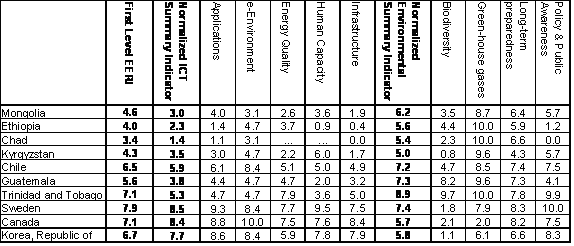<-
Back to the e-Environment Page
The EERI is a composite index based on
a select number of published primary indicators related to the environment and
ICT development levels. The EERI is a relative measure of the potential
contributions both positive and negative that ICTs make to:
A full description of the EERI and
its methodology is in the
e-Envrionment toolkit.
The criteria for the 26 selected EERI primary
indicators were established with the objective of enabling the EERI assessment
of a given country in a manner that will result in a meaningful interpretation
that can be used currently and going forward. The location of the raw data, the
weighting for each indicator and the tabulated outcome have been structured in
an excel spreadsheet that is populated with the available primary indicators.
The EERI takes these raw indicators
and presents values normalized between zero and 10 for the following categories:
Normalized ICT Summary Indicator
-
Application
-
e-Environment
-
Energy Quality
-
Human Capacity
-
Infrastructure
Normalized Environmental Summary
Indicator
The resulting composite EERI is then
calculated by weighting each of these categories. Since the primary indicators
are widely available over a number of years, the EERI could be used to provide
trend analysis over time. In addition, since the EERI shows both the
consolidated value as well as normalized categories, it can be used to identify
sectors that are either improving or degrading within the EERI.

EERI calculation for a sample
of countries
Comparisons between countries show
that that there are variations between the level of economic development in a
country, the status of the environment and the usage and availability of ICTs.
The EERI can be used within a country or as a comparison between countries in
directing policy around the potential positive and negative impacts of ICTs on
the environment and the sectors that are most impacted by ICTs.
Interpretation could be performed at
all three levels of the tiered indicators, in order to identify:
-
Country weaknesses or strengths
-
Specific areas that can be tackled to create gains in
either the ICT or environment domains
-
Areas of specific interest that can be isolated and
analyzed further
First level global EERI world map
2009 (for 132 countries where data is available)
The EERI is to be used along with
other tools and resources outlined in the e-Environment Toolkit. Together these
tools are designed to assist countries and organizations assess the potential
that ICTs have to contribute to abating C emissions and to reduce energy
consumption.
The EERI will be enhanced and improved
over time as more experience and further knowledge of its application are
acquired.
<-
Back to the e-Environment Page



